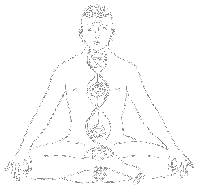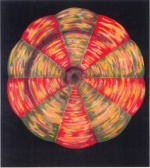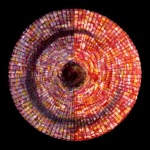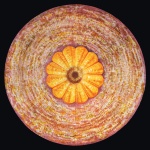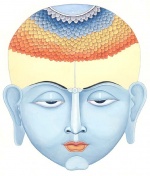Chakras: Difference between revisions
No edit summary |
No edit summary |
||
| Line 7: | Line 7: | ||
===Introduction=== | ===Introduction=== | ||
[[File:Channels.gif|200px|thumb|left]] | |||
According to many Tantric texts, the human body contains 72,000 nadis that channel prana (life force) to every cell. | According to many Tantric texts, the human body contains 72,000 nadis that channel prana (life force) to every cell. | ||
Revision as of 19:27, 5 July 2018
The word chakra is Sanskrit, means “wheel” and refers to energy centers that exist in the physical, emotional, and spiritual bodies. These force centers are points of connections at which energy flows from one body of a man to another. At each chakra, the concentrated energy spins around a central point, like a wheel spinning around an axle. Clairvoyants can see them in the etheric double. All these wheels are perpetually rotating and a force from the higher world is always flowing into them - in the undeveloped person usually sluggishly, in a more evolved person they may be glowing and pulsating. [1]
Each chakra deals with a different aspect of human experience and produces a particular state of consciousness. The chakras also involve a hierarchy of needs, from physical and emotional to intellectual and spiritual.
Different traditions have different views about the number and exact location of the chakras. Some are considered major, some minor, but most traditions refer to seven chakras that lie along the length of the spine, from the first chakra at its base to the seventh chakra about the crown of the head. [2]
Introduction
According to many Tantric texts, the human body contains 72,000 nadis that channel prana (life force) to every cell.
Three nadis are of particular interest. The sushumna runs from the base of the spine to the crown of the head, passing through each of the seven chakras in its course. It is the channel through which kundalini shakti (the latent serpent power) rises up from its origin at the muladhara (first or root) chakra to its true home at the sahasrara (seventh or thousand-fold) chakra at the crown of the head. In subtle body terms, the sushumna nadi is the path to enlightenment. The ida and pingala nadis spiral around the sushumna nadi, crossing each other at every chakra. Eventually, all three nadis meet at the ajna (sixth) chakra.[3][4][5]
The anatomy of the chakras has been described in Indian and Tibetan tantric literature. The seven etheric chakras, which are very important for the health of the physical and etheric bodies, have their counterparts on the astral and mental level. Chakras are both the transmitters and the transformers of energy from field to filed. Their mechanism synchronizes the emotional, mental and the etheric energies. The charkas reveal a person’s quality of consciousness and degree of personal abilities and development. Each of the centers has special links to certain organs as well as with certain states of consciousness. [6]
Mme. Blavatsky teachings
Our seven Chakras are all situated in the head, and it is these Master Chakras which govern and rule the seven (for there are seven) principal plexuses in the body, and the forty-two minor ones to which Physiology refuses that name.[7]
And if the term plexus, in this application, does not represent to the Western mind the idea conveyed by the term of the anatomist, then call them Chakras or Padmas, or the Wheels, the Lotus Hearts and Petals. Remember that Physiology, imperfect as it is, shows septenary groups all over the exterior and interior of the body; the seven head orifices, the seven “organs” at the base of the brain, the seven plexuses (the pharyngeal, laryngeal, cavernous, cardiac, epigastric, prostatic, and the sacral plexus), etc., etc. . . . If asked whether the seven plexuses, or Tattvic centres of action, are the centres where the seven rays of the Logos vibrate, I answer in the affirmative, simply remarking that the rays of the Logos vibrate in every atom, for the matter of that.[8]
The Tântrists do not seem to go higher than the six visible and known plexuses, with each of which they connect the Tattvas; and the great stress they lay on the chief of these, the Mûladhâra Chakra (the sacral plexus), shows the material and selfish bent of their efforts towards the acquisition of powers. Their five Breaths and five Tattvas are chiefly concerned with the prostatic, epigastric, cardiac, and laryngeal plexuses. Almost ignoring the Agneya, they are positively ignorant of the synthesizing pharyngeal plexus. But with the followers of the old school it is different. We begin with the mastery of that organ which is situated at the base of the brain, in the pharynx, and called by Western anatomists the Pituitary Body.[9]
According to Leadbeater
Root chakra
Spleen chakra
The second chakra mentioned by C. W. Leadbeater is the spleen chakra. This does not correspond to the Hindu svādhiṣṭhāna chakra, usually listed as the second one, and connected to the sexual organs:
The spleen chakra is not indicated in the Indian books; its place is taken by a centre called the Svadhishthana, situated in the neighbourhood of the generative organs, to which the same six petals are assigned. From our point of view the arousing of such a centre would be regarded as a misfortune, as there are serious dangers connected with it. In the Egyptian scheme of development elaborate precautions were taken to prevent any such awakening.[10]
Regarding its function, Leadbeater wrote:
The second centre, the splenic (Plate II), at the spleen, is devoted to the specialization, subdivision and dispersion of the vitality which comes to us from the sun. That vitality is poured out again from it in six horizontal streams, the seventh variety being drawn into the hub of the wheel. This centre therefore has six petals or undulations, all of different colours, and is specially radiant, glowing and sunlike. Each of the six divisions of the wheel shows predominantly the colour of one of the forms of the vital force--red, orange, yellow, green, blue and violet.[11]
The effects of its awakening were described as follows:
When the second of the etheric centres, that at the spleen, is awakened, the man is enabled to remember his vague astral journeys, though sometimes only very partially. The effect of a slight and accidental stimulation of this centre is often to produce half-remembrance of a blissful sensation of flying through the air.[12]
Heart chakra
Throat chakra
Brow chakra
Although in Hinduism the Ājñā chakra is traditionally connected to the Third Eye, Mme Blavatsky did not support the idea that this eye was really between the eyebrows.[13] Accordingly, C. W. Leadbeater said that the brow chakra is connected with the pituitary gland and not with the pineal, which is regarded are the real "third eye" in Theosophy.[14]
Leadbeater described the brow chakra as follows:
The sixth centre, the frontal (Plate IX), between the eyebrows, has the appearance of being divided into halves, one chiefly rose-coloured, though with a great deal of yellow about it, and the other predominantly a kind of purplish-blue, again closely agreeing with the colours of the special types of vitality that vivify it. Perhaps it is for this reason that this centre is mentioned in Indian books as having only two petals, though if we are to count undulations of the same character as those of the previous centres we shall find that each half is subdivided into forty-eight of these, making ninety-six in all, because its primary force has that number of radiations.[15]
Regarding its function, Leadbeater wrote:
When the sixth [chakra], between the eyebrows, becomes vivified, the man begins to see things, to have various sorts of waking visions, sometimes of places, sometimes of people. In its earlier development, when it is only just beginning to be awakened, it often means nothing more than half-seeing landscapes and clouds of colour. The full arousing of this brings about clairvoyance.
The centre between the eyebrows is connected with sight in yet another way. It is through it that the power of magnification of minute physical objects is exercised. A tiny flexible tube of etheric matter is projected from the centre of it, resembling a microscopic snake with something like an eye at the end of it. This is the special organ used in that form of clairvoyance, and the eye at the end of it can be expanded or contracted, the effect being to change the power of magnification according to the size of the object which is being examined. This is what is meant in ancient books when mention is made of the capacity to make oneself large or small at will. To examine an atom one develops an organ of vision commensurate in size with the atom. This little snake projecting from the centre of the forehead was symbolized upon the head-dress of the Pharaoh of Egypt, who as the chief priest of his country was supposed to possess this among many other occult powers.[16]
Crown chakra
C. W. Leadbeater connected the "crown chakra" with the pineal, which is regarded as the "third eye" in Theosophy.[17] He described this center as follows:
The seventh centre, the coronal, at the top of the head, is when stirred into full activity the most resplendent of all, full of indescribable chromatic, effects and vibrating with almost inconceivable rapidity. It seems to contain all sorts of prismatic hues, but is on the whole predominantly violet. It is described in Indian books as thousand-petalled, and really this is not very far from the truth, the number of the radiations of its primary force in the outer circle being nine hundred and sixty.
. . .
This chakra is usually the last to be awakened. In the beginning it is the same size as the others, but as the man progresses on the Path of spiritual advancement it increases steadily until it covers almost the whole top of the head. Another peculiarity attends its development. It is at first a depression in the etheric body, as are all the other, because through it, as through them, the divine force flows in from without; but when the man realizes his position as a king of the divine light, dispensing largesse to all around him, this chakra reverses itself, turning as it were inside out; it is no longer a channel of reception but of radiation, no longer a depression but a prominence, standing out from the head as a dome, a veritable crown of glory.[18]
Regarding its function, he wrote:
When the seventh centre is quickened, the man is able by passing through it to leave his body in full consciousness, and also to return to it without the usual break, so that his consciousness will be continuous through night and day. When the fire has been passed through all these centres in a certain order (which varies for different types of people) the consciousness becomes continuous up to the entry into the heaven-world at the end of the life on the astral plane, no difference being made by either the temporary separation from the physical body during sleep or the permanent division at death.[19]
In Hinduism
Talking about the ājñā chakra, Swami Satyananda Saraswati said:
There is a certain problem with the awakening of the other chakras. Each one contains a store of karmas or samskara, both good and bad, positive and negative, painful and pleasant. The awakening of any chakra will definitely bring to the surface an explosion or expression of these karmas, and of course, not everybody is prepared or ready to face them. Only those who have reason and understanding are able to cope. Therefore it is said that before you start awakening and manifesting the great force, it is best to purify the mind at the point of confluence. Then, with a purified mind, you can awaken the other chakras.[20]
Mūlādhāra chakra
Svādhiṣṭhāna chakra
Maṇipūra chakra
Anāhata chakra
Viśuddha chakra
Ājñā chakra
Ajna chakra is the point of confluence where the three main nadis or forces - ida, pingala and sushumna merge into one stream of consciousness and flow up to sahasrara, the crown center.[21]
Sahasrāra chakra
Online resources
Articles
- Chakra at Theosopedia
Video
- The Structure and Function of the Chakras by Dora Kunz and Shafica Karagulla
Notes
- ↑ Charles Webster Leadbeater, Annotations by Kurt Leland, The Chakras, (Wheaton, Ill: The Theosophical Publishing House, 2013), p. 1- 5
- ↑ Kurt Leland, The Chakras: A Magical Mystery Tour, presented on March 9, 2017. https://www.youtube.com/watch?v=12IfYlChipM&t=1216s
- ↑ James Bailey, Discover the Ida and Pingala Nadis. August 28, 2007. https://www.yogajournal.com/yoga-101/balancing-act-2
- ↑ Charles Webster Leadbeater, Annotations by Kurt Leland, The Chakras, (Wheaton, Ill: The Theosophical Publishing House, 2013), p. 25-27
- ↑ Kurt Leland, Rainbow Body: A History of the Western Chakra System from Blavatksy to Brennan, (Lake Worth, Fl: Ibis Press, 2016), p. 47-48
- ↑ Shafica Karagulla, M.C. and Dora van Gelder Kunz, The Charkas and the Energy Fields, (Wheaton, Ill: The Theosophical Publishing House, 1989) p. 33-38
- ↑ Helena Petrovna Blavatsky, Collected Writings vol. XII (Wheaton, IL: Theosophical Publishing House, 1980), 619.
- ↑ Helena Petrovna Blavatsky, Collected Writings vol. XII (Wheaton, IL: Theosophical Publishing House, 1980), 620.
- ↑ Helena Petrovna Blavatsky, Collected Writings vol. XII (Wheaton, IL: Theosophical Publishing House, 1980), 616.
- ↑ Charles Webster Leadbeater, The Chakras, (Wheaton, Ill: The Theosophical Publishing House, 1987), 7, fn.
- ↑ Charles Webster Leadbeater, The Chakras, (Wheaton, Ill: The Theosophical Publishing House, 1987), 12, fn.
- ↑ Charles Webster Leadbeater, The Chakras, (Wheaton, Ill: The Theosophical Publishing House, 1987), 78.
- ↑ Helena Petrovna Blavatsky, The Secret Doctrine vol. II, (Wheaton, IL: Theosophical Publishing House, 1993), 295.
- ↑ Charles Webster Leadbeater, The Chakras, (Wheaton, Ill: The Theosophical Publishing House, 1987), 10.
- ↑ Charles Webster Leadbeater, The Chakras, (Wheaton, Ill: The Theosophical Publishing House, 1987), 13-14.
- ↑ Charles Webster Leadbeater, The Chakras, (Wheaton, Ill: The Theosophical Publishing House, 1987), 79
- ↑ Charles Webster Leadbeater, The Chakras, (Wheaton, Ill: The Theosophical Publishing House, 1987), 10.
- ↑ Charles Webster Leadbeater, The Chakras, (Wheaton, Ill: The Theosophical Publishing House, 1987), 14-15.
- ↑ Charles Webster Leadbeater, The Chakras, (Wheaton, Ill: The Theosophical Publishing House, 1987), 80.
- ↑ Swami Satyananda Saraswati, Kundalini Tantra (Munger, Bihar, India: Yoga Publications Trust, 2001), Chapter 3.
- ↑ Swami Satyananda Saraswati, Kundalini Tantra (Munger, Bihar, India: Yoga Publications Trust, 2001), Chapter 3.
